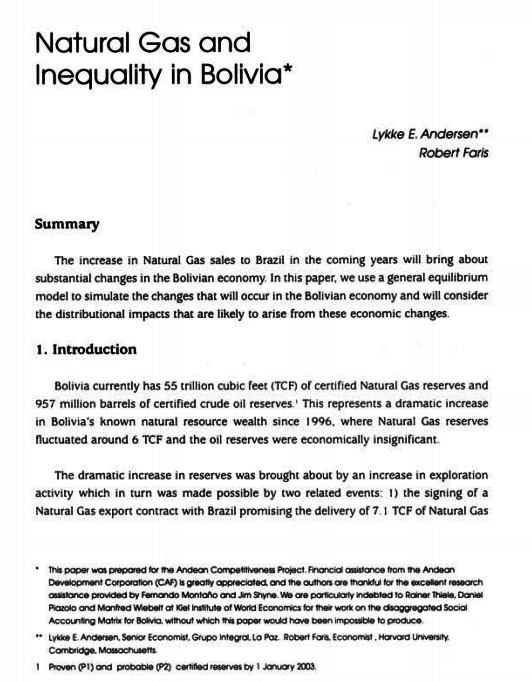Natural Gas and Inequality in Bolivia
DOI:
https://doi.org/10.35319/lajed.20042320Keywords:
Gas sales, BoliviaAbstract
The increase in Natural Gas sales to Brazil in the coming years will bring about substantial changes in the Bolivian economy. In this paper, we use a general equilibrium model to simulate the changes that will occur in the Bolivian economy and will consider the distributional impacts that are likely to arise from these economic changes.
Downloads
References
Andersen, L. E. (2003) “Baja Movilidad Social en Bolivia: Causas y Consecuencias Para el Desarrollo” Revista Latinoamericano de Desarrollo Económico, No. 1, pp. 11-36. Septiembre.
Andersen, L. E. and R. Faris (2001) “Reducing volatility due to Natural Gas exports: Is the answer a Stabilization Fund?” Institute for Socio-Economic Research, Universidad Católica Boliviana. Working Paper No. 11/2001. December.
Auty, Richard M. (1997) “Natural Resources, the state and development strategy.” Journal of International Development, Vol. 9, pp. 651-63.
Auty, Richard M. (1998) “Resource Abundance and Economic Development: Improving the Performance of Resource-Rich Countries” UNU/WIDER Research for Action No. 44.
Auty, R. M. and R. F. Mikesell (1999) Sustainable Development of Mineral Economies, Oxford: Oxford University Press.
Birdsall, N., D. Ross and R. Sabot (1997) “Education, growth and inequality,” in N. Birdsall and F. Jasperson (eds) Pathways to Growth: Comparing East Asia and Latin America, Washington DC: Inter-American Development Bank, pp. 93-127.
Blanchflower & Osward (1994) “An Introduction to the Wage Curve” Journal of Economic Perspectives Vol. 9:153-167.
Davis, G. A. (1995) “Learning to love the Dutch disease: Evidence from the mineral economies,” World Development, Vol. 23, pp. 1765-1779.
De Santis (2000) “The Impact of a Custons Union with the EU on Turkey’s Welfare, Employment and Income Distribution: An AGE Model with Alternative Labour Market Structures” Journal of Economic Integration Vol. 15: 195-238.
Duncan, R. C. (1993) “Agricultural export prospects for sub-Saharan Africa,” Development Policy Review, Vol. 11, pp. 31-45.
Easterly, William (2001) The Elusive Quest for Growth. Cambridge: MIT Press.
ECLAC (1997) The Equity Gap. Latin America, the Caribbean and the Social Summit. Santiago, Chile: Economic Commission for Latin America and the Caribbean.
Gylfason, T. et al. (1999) “A Mixed Blessing: Natural Resources and Economic Growth,” Macroeconomic Dynamics, vol. 3, pp. 204-225.
Gylfason, T. (2001) “Natural resources, education, and economic development,” European Economic Review, vol. 45, pp. 847-859.
Hirschman, A. O. (1958) The Strategy of Economic Development. Yale studies in economics, 10, Yale University Press, New Haven.
IDB (1998) “Facing Up to Inequality in Latin America.” The Inter-American Development Bank, Washington, D.C.
Karl, T. L. (1997) The Paradox of Plenty: Oil Booms, Venezuela, and Other Petro-States. Berkeley: University of California Press.
Lal, D. (1993) The Repressed Economy: Causes, Consequences, Reform. London: Edward Elgar.
Leamer, E. E., H. Maul, S. Rodriguez and P. Schott (1999) “Does Natural Resource Abundance Increase Latin American Income Inequality?” Journal of Development Economics, Vol. 59, pp. 3-42.
Matsuyama, K. (1992) “Agricultural productivity, comparative advantage, and economic growth” Journal of Economic Theory, vol. 58, pp. 317-334.
Nankini, G. T. (1979) “Development problems of mineral exporting countries,” World Bank Staff Working Paper No. 354, Washington DC: World Bank.
Pritchett, L. (2000) “The Tyranny of Concepts: CUDIE (Cumulated, Depreciated, Investment Effort) is Not Capital,” Journal of Economic Growth vol. 5, pp. 361-384.
Sachs, J. and A.. Warner (1995) “Natural Resource Abundance and Economic Growth,” NBER Working Paper No. 5398, Cambridge MA: National Bureau of Economic Research.
Sachs, J. and A.. Warner (1999) “The Big Push, Natural Resource Booms and Growth,” Journal of Development Economics, vol. 59, pp. 43-76.
Stijns, Jean-Philippe (2001) “Natural Resource Abundance and Human Capital Accumulation,” University of California at Berkeley, Department of Economics, Draft.
Thiele, Rainer and Daniel Piazolo (2002) “Constructing a Social Accounting Matrix with a Distributional Focus - The Case of Bolivia” Kiel Institute of World Economics. Working Paper No.1094. January.
Tornell, A. and P. Lane (1994) “Are Windfalls a Curse? A Non-Representative Agent Model of the Current Account and Fiscal Policy,” NBER Working Paper No. 4839, Cambridge MA: National Bureau of Economic Research.
Williamson, J. G. (1997) “Growth, distribution and demography: Some lessons from history,” NBER Working Paper No. 6244, Cambridge MA: National Bureau of Economic Research.
Wood, A. and K. Berge (1997) “Exporting manufactures: Human resources, natural resources and trade policy,” Journal of Development Studies, Vol. 34, pp. 35-59.
YPFB (2001) “Informe Mensual Noviembre – Diciembre 2000” Vicepresidencia de Negociaciones Internacionales y Contratos. La Paz.






